Introduction: In this article, Duncan Kuehn describes how DNA research may help solve a missing person case from 1926. Duncan is a professional genealogist with over eight years of client experience. She has worked on several well-known projects, such as “Who Do You Think You Are?” and researching President Barack Obama’s ancestry.
One of the oldest missing person cases may be solved.
Recently in the news, there was a report saying that one of the oldest missing persons cases may be solved using DNA. The details of the story were somewhat disjointed, but this is the basic story.

Marvin was destined to become a “missing person” case.

Marvin’s Family Background
Marvin’s mother Mary had at least two husbands following Marvin’s father George. She becomes a crucial part of this mystery. (See the footnote at the end of this article for further details.)
Marvin and Mary Clark had many children, but two factor into our story. (6) Their daughter Sidney McDougal had been living 180+ miles away in Seattle, Washington. (7) By 1926, she had moved to Portland, not far from her brother Grover, where she was a hotel manager. Grover C. Clark was already living in Portland, just 10 miles away from his parents Marvin and Mary. (8)
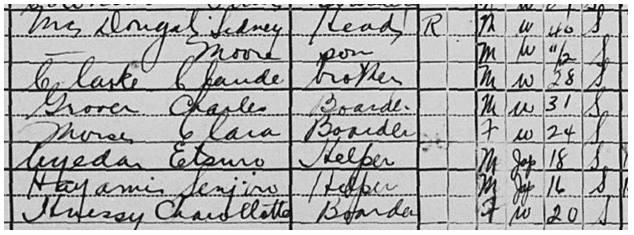

Disappearance the Night before Halloween
The details of the story are a little confusing, but it appears that Marvin left his home in Tigard to visit his daughter Sidney in Portland the night before Halloween in 1926. This was a ten-mile trip, but he did not inform his daughter that he would be visiting. Nor did he take a coat with him on what would likely have been a chilly fall day in the Northwest.
Marvin never made it to his daughter’s home that day—he simply disappeared.
This newspaper article reported his disappearance.
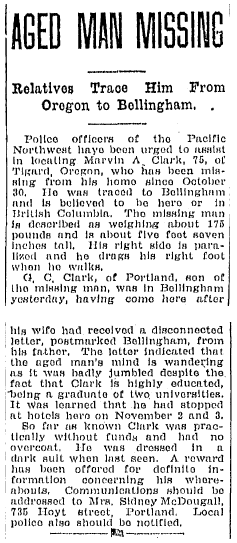
This 1900s newspaper article reported that Grover’s wife had received a letter from his 75-year-old father postmarked Bellingham, Washington. The letter disturbed the family because it was “disconnected.” According to the article:
The letter indicated that the aged man’s mind is wandering as it was badly jumbled despite the fact that Clark is highly educated, being a graduate of two universities.
The old newspaper article also reported that “so far as known Clark was practically without funds,” and that “he had stopped at hotels here [Bellingham] on November 2 and 3.”
The article provided a brief description of Marvin:
The missing man is described as weighing about 175 pounds and is about five feet seven inches tall. His right side is paralyzed and he drags his right foot when he walks.
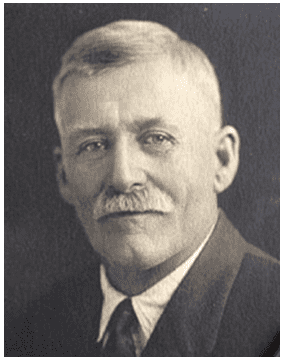
Searching for Marvin Clark
His family frantically searched for him. The police did their best to locate the man. The family even offered a reward of $100, which would be about $1,300 in today’s dollars. Because of Marvin’s previous profession as a marshal, the family feared the worst—knowing he had made enemies in his law enforcement career.
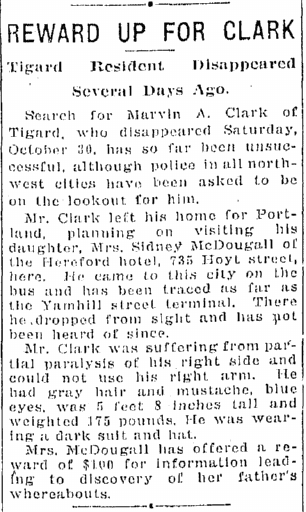
And so a generation passed away with no sight or sound of Marvin. His wife and children never knew what happened to him. But, in fact, Marvin was never far away.
Skeleton Tied to Old Missing Persons Case
In 1986 a body was found in the woods, as this newspaper article reported:
…loggers were clearing an isolated section of Portland when they discovered the remains of a mystery man who had been dead for at least half a century.
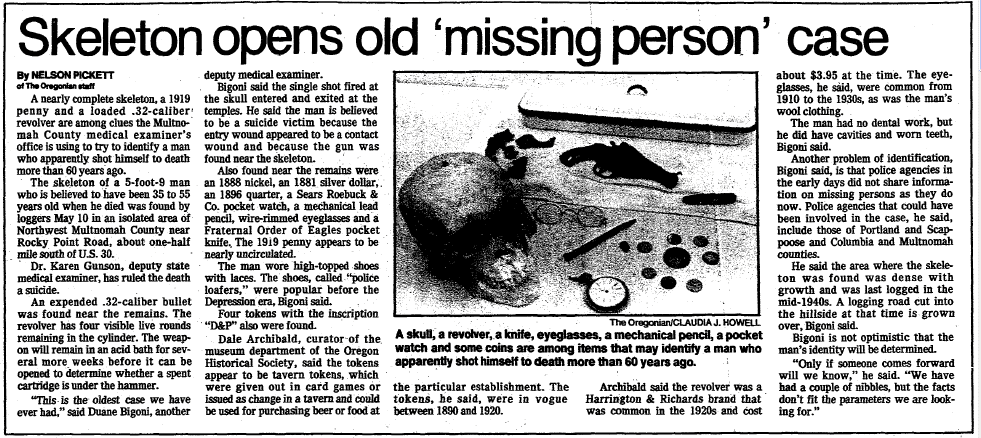
The skeleton had a single bullet hole through the temples and the gun was nearby. Police deemed the death a suicide from around the 1920s based on the clothing and personal items.
At the time of Marvin’s disappearance, the family had not considered suicide a possibility. Because of Marvin’s previous profession as a marshal, the family had feared an attack. Alternatively, they feared he had become disoriented and lost due to his seemingly diminished mental capacity as portrayed in the letter Grover’s wife received.
The skeleton was in such good shape that the medical examiner initially guessed the age as between 35 and 55. This cast doubt on Marvin’s granddaughter’s claim a few days later that the body might belong to her long-missing grandfather. Nothing was able to verify or disprove her claim, and she died in 1991 without closure and without leaving a DNA sample.
And so the case remained unsolved until 2011 when, according to the recent article in the Daily Mail by Dan Bloom (10):
Dr. Nici Vance, from the Oregon state medical examiner’s office, found the file on the suicide and began investigating.
Amazingly, 90 years after Marvin went missing, the remains were still in storage and DNA may yet solve the case. Several great grandchildren on Marvin’s paternal side have been found and DNA samples have been procured. Now they are looking for a maternal link in order to get a clearer profile. Perhaps you will be the one to find living descendants whose DNA will definitively solve the case of the missing Marvin A. Clark! Please let us know if you can help resolve this unsolved missing person mystery.
Notes
(1) Dan Bloom, “Could One of America’s Oldest Missing Person Cases Finally Be Solved? Investigators Hope DNA Will Unravel Mystery of Man Who Vanished in 1926,” Daily Mail, published 30 April 2014. http://www.dailymail.co.uk/news/article-2616542/DNA-sought-close-1926-missing-person-case.html.
(2) “United States Census, 1920,” index and images, FamilySearch. https://familysearch.org/pal:/MM9.1.1/M48P-T8J. Accessed 11 June 2014. Marvin A. Clark, Tigard, Oregon, United States; citing sheet 4B, family 92, NARA microfilm publication T625, FHL microfilm 1821505.
(3) “United States Census, 1900,” index and images, FamilySearch. https://familysearch.org/pal:/MM9.1.1/M31Q-Y27. Accessed June 2014, Marvin Clark, Pender Precinct, Thurston, Nebraska, United States; citing sheet 13A, family 253, NARA microfilm publication T623, FHL microfilm 1240941.
(4) Associated Press, “Investigators Seek DNA to Close 1926 Oregon Missing Person Case,” Fox News: Accessed June 2014.
(5) Possible census returns for Marvin Clark and his mother Mary/Miranda.
“United States Census, 1880,” index and images, FamilySearch. https://familysearch.org/pal:/MM9.1.1/MDL3-LP2. Accessed June 2014, Marvin Clark in household of Nickolus Fritz, St. Marys, Mills, Iowa, United States; citing sheet 267D, NARA microfilm publication T9.
“United States Census, 1870,” index and images, FamilySearch. https://familysearch.org/pal:/MM9.1.1/MDVL-G3D. Accessed June 2014, Marvin Clark in household of William Fiedler, Iowa, United States; citing page 3, family 18, NARA microfilm publication M593, FHL microfilm 000545910.
“United States Census, 1860,” index, FamilySearch. https://familysearch.org/pal:/MM9.1.1/MXR1-CC7. Accessed June 2014, Marvin Clark in household of Geo Clark, Girard Tp, Erie, Pennsylvania, United States; citing “1860 U.S. Federal Census-Population,” Fold3.com; page 31, household ID 228, NARA microfilm publication M653; FHL microfilm 805107.
(6) “United States Census, 1910,” index and images, FamilySearch. https://familysearch.org/pal:/MM9.1.1/MLB7-GL7. Accessed June 2014, Marvin A. Clark, Holbrook, Multnomah, Oregon, United States; citing enumeration district (ED) 121, sheet 4A, family 80, NARA microfilm publication T624, FHL microfilm 1375301.
(7) “United States Census, 1920,” index and images, FamilySearch. https://familysearch.org/pal:/MM9.1.1/MHNT-NH8. Accessed June 2014, Sidney McDougal, Seattle, Washington, United States; citing sheet 4A, family 59, NARA microfilm publication T625, FHL microfilm 1821928.
(8) “United States Census, 1920,” index and images, FamilySearch. https://familysearch.org/pal:/MM9.1.1/M48N-8VP. Accessed June 2014, Grover C. Clark, Portland, Oregon, United States; citing sheet 14A, family 359, NARA microfilm publication T625, FHL microfilm 1821501.
(9) Bloom.
(10) Bloom.

Wikipedia indicates that a 2018 DNA investigation found that the John Doe remains are not Marvin Clark.
I was amazed that a case that old would still be considered “open”. Is there any time limit, or could Marvin potentially remain the oldest
“missing person” case in perpetuity?